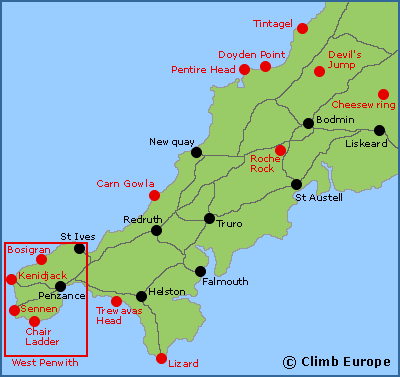Rock climbing in Cornwall
Cornwall contains some of Britain’s best rock climbing with hundreds of fantastic routes across a wide range of grades and styles. The 3 main rock climbing areas of Cornwall are as follows:
- West Penwith at the tip of Cornwall has many mid-grade trad classics routes on perfect granite sea cliffs.
- The Cornish Atlantic Coast provides huge, committing sea cliff adventures.
- Inland Cornwall provides technical sport and trad routes amongst granite quarries and tors on Bodmin Moor.
Rock climbing in West Penwith
West Penwith is the focal point of rock climbing in Cornwall. Its great granite sea cliffs and beautiful coastal scenery form a world-class trad climbing experience across a wide range of grades. There are around 20 different crags of varying size dotted around the coast of West Penwith. Bosigran and Sennen are by far the most popular crags due to their ease of access, size and good spread of grades. At Bosigran there are multi-pitch routes between 3 and 5 pitches long that have the advantage of being non-tidal.
Map of the main rock climbing areas in Cornwall

Apart from Bosigran and Sennen, the vast majority of the West Penwith crags are in wild and exposed positions that often require an abseil descent. The largest of these is Chair Ladder with its multi-pitch sea cliff climbing. The start of the routes are only accessible for 3 hours either side of low tide in calm seas, so climbers often find themselves high on a buttress of rough sun-baked granite with the sea crashing below. Not all of the crags in West Penwith are granite as typified by Kenidjack an excellent crag of quartz-flecked killas slate. This crag has a number of sustained wall climbs such as the classic 3-star route of Saxon, HVS 5a.
There are 2 definitive rock climbing guidebooks for West Penwith, which are: Cornwall – Bosigran and the North Coast rock climbing guidebook; and Cornwall - Chair Ladder and The Lizard rock climbing guidebook.
Rock climbing on the Atlantic Coast of Cornwall
Between Boscastle and St Ives there are some of the highest sea cliffs on the British mainland. These tall shale cliffs provide some of the most serious routes in Britain, with many crags plunging straight into a hostile sea, giving access and escape problems. The majority of the routes are in the E grades, and this combination of length, difficulty, seriousness and variable rock quality require total commitment, but are highly adventurous and rewarding. Some of the more popular crags (and hence slightly more reliable rock) are Tintagel, Doyden Point, Pentire Head and Carn Gowla.
The definitive rock climbing guidebook for the Atlantic Coast of Cornwall is called North Devon and Cornwall rock climbing guidebook.
Rock climbing in central and south east Cornwall
Cheesewring is the largest crag in central Cornwall. This granite quarry has a mixture of trad and sport routes up to 30m high. Due to the nature of the quarried granite, the routes are very technical with little in the way of intermediate holds. Scattered over the interior of Cornwall is a small number of granite tors mainly on Bodmin Moor that offer a good range of mid-grade trad routes, at crags such as Roche Rock.
The south east coast of Cornwall has a good mixture of rock climbing. This ranges from adventurous multi-pitch climbing on suspect rock to deep water soling (DWS) at Nare Head and Pencarrow Head, plus bouldering at Downderry beach.
The definitive rock climbing guidebook for central and south east Cornwall is called Cheesewring and South East Cornwall Rock Climbing Guidebook.
There are also a couple of selective guidebooks covering the best rock climbing in Cornwall. These are:
West Country Climbs by Rockfax covers selective routes in Cornwall including West Penwith, the Atlantic Coast, and Cheesewring. As well as Cornwall guidebook also covers Devon, Dorset, Avon and Somerset.
South West Climbs Volume 2 Guidebook covers selective routes in Cornwall including West Penwith, the Atlantic Coast, and Bodmin Moor tors. As well as Cornwall this guidebook also covers Devon and the Channel Islands.